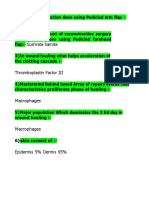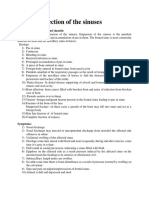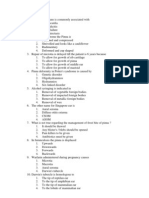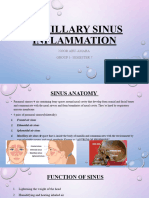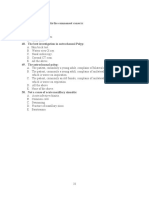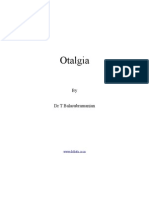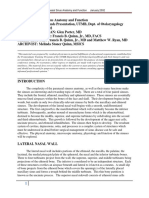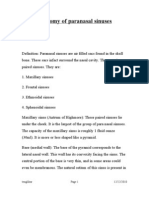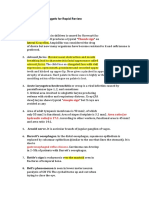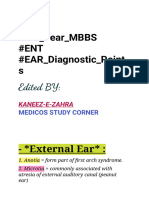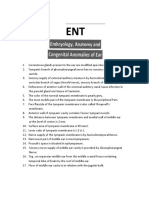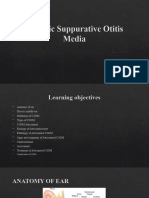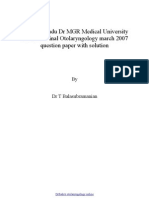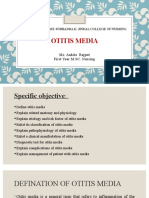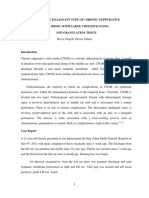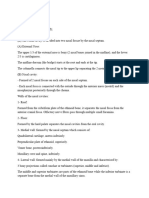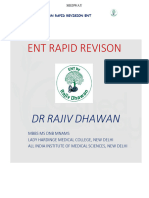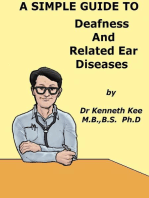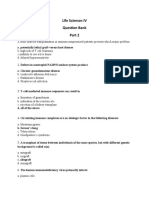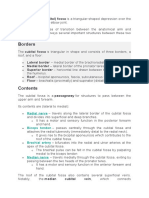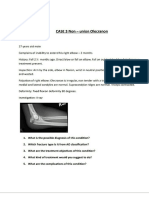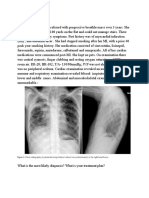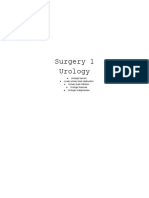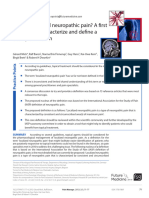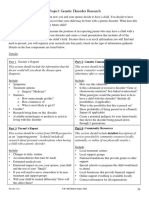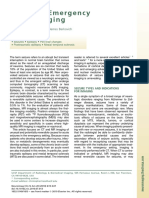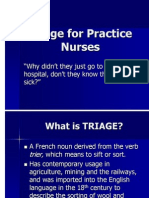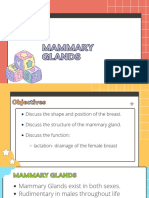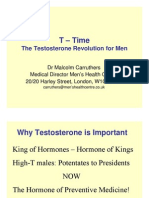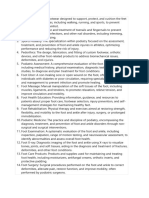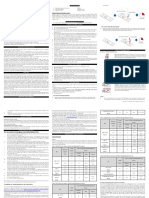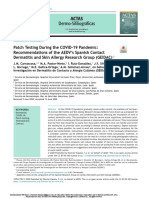MCQ Final
MCQ Final
Uploaded by
Jerin XavierCopyright:
Available Formats
MCQ Final
MCQ Final
Uploaded by
Jerin XavierOriginal Title
Copyright
Available Formats
Share this document
Did you find this document useful?
Is this content inappropriate?
Copyright:
Available Formats
MCQ Final
MCQ Final
Uploaded by
Jerin XavierCopyright:
Available Formats
Maxillofacial
1. Earliest accounts of reconstructive surgery. Reconstruction of an amputated nose
with a pedicled forehead flap/ reconstruction of ear with cheek flaps
SUSHRUTA SAMHITA
2. Book describes reconstruction of the nose with pedicled arm flap.
GASPARA TAGLIACOZZI
3. Masterminds in proliferative healing phase populate on the third day
MACROPHAGES
4. Skin constitution- Epidermis 5% Dermis 95%
5. Acceleration of clotting cascade- FACTOR 3 THROMBOPLASTIN
6. Graft with low primary contraction, high secondary contraction
THIN SPLIT GRAFTS
7. Graft with high primary contraction and low secondary contraction
THICK SPLIT GRAFTS
8. Reconstruction of the nose requires appreciation of the NINE aesthetic subunits
9. Arteries that supply the lips
FACIAL ARTERY, and its branches- superior/ inferior labial arteries
10. There are five layers to the scalp: the skin, connective tissue layer, galea
aponeurotica, loose areolar connective tissue, and the pericranium
11. if parents have cleft lip chance of offspring being affected :- 4%
12. cleft palate repair- should be performed before development of speech
13. The most common orbital fracture is the orbital floor blow-out fracture caused by
direct pressure to the globe and sudden increase in intra-orbital pressure.
14. First line treatment hemangiomas: systemic corticosteroids
15. Best surgery pattern for cleft palate- double apposing Z plasty
16. Most common birthmark- hemangioma
17. Skin growth external factor- gravity
19) Injury to forehead and face causes :- Zygomatic bone fractures
11) in que :- Graft :- has no vascular pedicle /supply
14) lateral side damage of orbital fissure :- Zygomatic bone
Macrophages become the major
population by the third day after injury.
These cells then dominate the wound
region for days to weeks.
• Macrophages are the “masterminds”
behind the finely tuned array of repair
events that characterizes the
proliferative phase of healing.
Full-thickness skin grafts include the epidermis and the
complete layer of dermis.
❖ The subcutaneous tissue is carefully removed from the
deep
surface of the dermis to maximize the potential for
engraftment. Full-thickness grafts are associated with the
least secondary contraction upon healing, the best
cosmetic appearance, and the highest durability.
❖ As a result, they are frequently used in reconstructing
superficial wounds of the face and the hands.
Hemangioma- most common birth mark. Usually in first 2 weeks of life.
Skin incisions-
Human skin exists in a state of tension created by internal and external factors. Externally,
skin and underlying subcutaneous tissue are acted on by gravity and clothing. Internally, skin
is subjected to forces generated by underlying muscles, joint extension and flexion, and
tethering of fibrous tissues from zones of adherence.
ENT
1. Anosmia (loss of smell) common finding in all EXCEPT- acute otitis media
2. What is the acoustic neuroma feature EXCEPT- it is a fast growing tumor
3. Types of hearing loss- conductive, sensory neuro, mixed
4. The ear has three parts
5. Acute tonsilitis- tx sprays
6. Acute OM main sx- pain/ hearing loss
7. Change in tympanic membrane OM- red, perforation, discharge
8. Types of sinsus- maxillary, ethmoid, sphenoid, and frontal
9. Fungal infection otitis externa- aspergellis/ candida
10. Acute laryngitis- voice change
11. Otitis- viral, bacterial, fungal
12. what is true regarding inner ear except :- Cochlear part of the temporal bone
13. otosclerosis causes :- women are more affected
14. scala media is filled with perilymph (endolymph)
27) plastic
28) pir robins /Addison
Pierre Robin sequence is characterized by three
pathognomonic
findings: microretrognathia, glossoptosis, and respiratory dis-
tress. Pierre Robin sequence may or may not be associated
with
a palatal cleft.
29) complete bilateral /unilateral
32) enlarged adenoids
33) 8-10 cm
34) less than 25
35) less than 20
There are four paranasal sinuses, each corresponding with the respective bone from
which it takes its name: maxillary, ethmoid, sphenoid, and frontal
Otosclerosis is a hereditary localised
disease of the bone characterised by
alternating phases of bone resorption
and new bone formation. The
mature lamellar bone is removed by
osteoclasis and replaced by woven
bone of greater thickness, cellularity
and vascularity
The primary pathological change occurs in
the bony labyrinth with secondary effects
upon middle ear and inner ear
function. The otosclerotic focus may be
asymptomatic, or if present in the area of
foot plate of stapes it may give rise to
ankylosis of foot plate with resultant
conductive hearing loss or deafness.
Otosclerotic foci may involve other
portions of labyrinth causing sensori
neural hearing loss and vestibular
abnormalities.
Many theories have been proposed to
explain the etiological factors of
otosclerosis. They are:
1. Metabolic
15. Immune disorders
16. Vascular disease
17. Infection (Measles) currently
18. Accepted
19. Trauma : The petrous bone doesnot have
20. Temporal bone abnormalities
21. (congenital)
Otosclerosis is a condition in which there's abnormal bone growth inside the
ear. It's a fairly common cause of hearing loss in young adults. There are 3 tiny
bones deep inside the ear that vibrate when sound waves enter
More common in woman
What causes anosmia?
Nasal polyps.
Common cold.
Influenza (flu).
Nasal congestion.
A deviated septum.
Sinus infection (sinusitis).
Hay fever or other allergies
Anosmia is the medical term for a loss of sense of smell
An acoustic neuroma is a type of non-cancerous (benign) brain tumour. It's also
known as a vestibular schwannoma. A benign brain tumour is a growth in the brain
that usually grows slowly over many years and does not spread to other parts of the
body
What three regions is the Pharynx or throat divided into? Nasopharynx,
Oropharynx, Laryngopharynx/ hypopharynx
Glue ear is where the empty middle part of the ear canal fills up with fluid. This
can cause temporary hearing loss. 2 main treatments are temporary hearing aids
or grommets (small tubes implanted in the ear). Occasionally, surgery may be
recommended to remove some glands at the back of the nose (adenoids). This is
known as an adenoidectomy
-
-
- Acute tonsilitis- pain on swallowing/ swallowing problem
1. How many parts has pharynx? 3
2. Symptoms of acute tonsilitis? Pain during swallowing
3. Which is the most common symptom of acute tonsilitis? Swallowing problems
4. What kind of hearing loss do we know? All of the above – acute and chronic
5. What kind of hearing loss do we know? All of the above – conductive, sensory neuro,
mixed
6. How many parts does the ear have? 3
7. What is the best choice for acute tonsilitis? Pharyngeal spray
8. What is the main symptoms of acute otitis media? Ear pain
9. What is the main symptoms of acute otitis media? Hearing loss
10. What change will we find on the tympanic membrane during acute otitis media?
11. All of the above – discharge, perforation, redness
12. Types of sinuses? All of the above – maxillary, frontal, ethmoid, sphenoid
You might also like
- MCQ Final 2Document16 pagesMCQ Final 2Ahmad SobihNo ratings yet
- Some Important ENT PointsDocument3 pagesSome Important ENT PointsfrabziNo ratings yet
- ENT (Viva Answer Sheet)Document36 pagesENT (Viva Answer Sheet)Faria Islam Juhi100% (22)
- Nursing Management of Patient With Disorders of Ent Third YrDocument26 pagesNursing Management of Patient With Disorders of Ent Third YrShreyas Walvekar100% (4)
- ENT MaxillaryDocument21 pagesENT MaxillaryAhmad SobihNo ratings yet
- Dr. Amit Gupta Reader Department of Oral PathologyDocument55 pagesDr. Amit Gupta Reader Department of Oral PathologyAMIT GUPTANo ratings yet
- Anatomy and Physiology of Ent-OrgansDocument52 pagesAnatomy and Physiology of Ent-OrgansdrghassanNo ratings yet
- Affection of Sinus and Ear PDFDocument7 pagesAffection of Sinus and Ear PDFअनघा जाधवNo ratings yet
- Keratosis Obturans Is Commonly Associated WithDocument11 pagesKeratosis Obturans Is Commonly Associated WithAbouzr Mohammed ElsaidNo ratings yet
- Maxillary Sinus InflammationDocument12 pagesMaxillary Sinus InflammationnNo ratings yet
- The Ear AnatomyDocument23 pagesThe Ear AnatomyyasinoNo ratings yet
- ENT MCQforstudents AnswersDocument30 pagesENT MCQforstudents AnswersOla100% (1)
- ENT Crash CourseDocument15 pagesENT Crash CourseJovanNo ratings yet
- Acuteotitismedia1 180118101452 PDFDocument57 pagesAcuteotitismedia1 180118101452 PDFWael ShamyNo ratings yet
- Acute and Chronic Otitis MediaDocument29 pagesAcute and Chronic Otitis MediaKIBET ERNEST MUTAINo ratings yet
- Congenital Malformations of Temporal Bone: by Dr. T. Balasubramanian M.S. D.L.ODocument16 pagesCongenital Malformations of Temporal Bone: by Dr. T. Balasubramanian M.S. D.L.OIvan DarioNo ratings yet
- Otalgia by DrtbaluDocument13 pagesOtalgia by DrtbaluDr. T. Balasubramanian100% (2)
- Paranasal SinusesDocument9 pagesParanasal SinusesSaima AhmedNo ratings yet
- Tamil Nadu DR MGR Medical University ENT MBBS Prefinal Feb 2009 Question Paper With SolutionDocument21 pagesTamil Nadu DR MGR Medical University ENT MBBS Prefinal Feb 2009 Question Paper With SolutionDr. T. BalasubramanianNo ratings yet
- Osama Mini Osce ENTDocument117 pagesOsama Mini Osce ENThometechonoNo ratings yet
- Chronic Otitis Media (Mesotympanitis. Epitympanitis) - Otogenous Intracranial ComplicationsDocument53 pagesChronic Otitis Media (Mesotympanitis. Epitympanitis) - Otogenous Intracranial Complicationssimi yNo ratings yet
- Blank-2023-09-16 22-28-41Document6 pagesBlank-2023-09-16 22-28-41adham bani younesNo ratings yet
- Anatomy of Paranasal SinusesDocument8 pagesAnatomy of Paranasal SinusesPavan TenglikarNo ratings yet
- Ent NursingDocument141 pagesEnt NursingMwangi BossNo ratings yet
- Diseases of The External Ear 2Document57 pagesDiseases of The External Ear 2Mimo HemadNo ratings yet
- Ent Past Years Question According To TopicsDocument32 pagesEnt Past Years Question According To Topicsmohamed100% (1)
- Revision Note - 1 - ENT NuggetsDocument4 pagesRevision Note - 1 - ENT NuggetsNicNo ratings yet
- Diffuse Otitis Externa: Case ReportDocument21 pagesDiffuse Otitis Externa: Case ReportKalvin DersingNo ratings yet
- Ent Diagnosis (Kaneez-E-Zahra)Document16 pagesEnt Diagnosis (Kaneez-E-Zahra)hamzaw213No ratings yet
- THT: IntroducingDocument33 pagesTHT: IntroducingqurataNo ratings yet
- The Ear History & Hearing TestsDocument5 pagesThe Ear History & Hearing TestsNoelle Grace Ulep BaromanNo ratings yet
- Ent LMRP 2019Document24 pagesEnt LMRP 2019skNo ratings yet
- Auditory ProblemsDocument55 pagesAuditory ProblemsHershey Cordero Briones100% (1)
- ENT 2marksDocument10 pagesENT 2marksSaileekitha AjamoniNo ratings yet
- Chronic Suppurative Otitis MediaDocument34 pagesChronic Suppurative Otitis Mediafreelancer.am1302No ratings yet
- Ent Q&aDocument7 pagesEnt Q&aZoha TariqNo ratings yet
- Group 2 - Study GuideDocument18 pagesGroup 2 - Study GuideMa. Sofia Andrei AlcabazaNo ratings yet
- Q Oral IU 2023Document4 pagesQ Oral IU 2023Kin molikaNo ratings yet
- MGRUniv UGMar07Document32 pagesMGRUniv UGMar07Dr. T. BalasubramanianNo ratings yet
- Papadopoulos15 5Document28 pagesPapadopoulos15 5Ellizabeth LilantiNo ratings yet
- PRACTICE TEACHING On Otitis Media FinalDocument33 pagesPRACTICE TEACHING On Otitis Media FinalAjit ThangeNo ratings yet
- Congenital MalformationsDocument16 pagesCongenital MalformationsJohn Christopher LucesNo ratings yet
- Important Topics in OtologyDocument94 pagesImportant Topics in OtologyDr. T. Balasubramanian100% (1)
- EarDocument33 pagesEarHikmat UllahNo ratings yet
- Maxillary Sinus Lec18 DR - Nada AL GhabanDocument7 pagesMaxillary Sinus Lec18 DR - Nada AL Ghabanbhatiamadhvi4No ratings yet
- A Mini-Atlas of Ear-Drum Pathology PDFDocument7 pagesA Mini-Atlas of Ear-Drum Pathology PDFalexandra_i_nitaNo ratings yet
- CSOM of Middle Ear Part 1Document59 pagesCSOM of Middle Ear Part 1Anindya Nandi100% (2)
- Maxillary Air Sinus OralDocument49 pagesMaxillary Air Sinus OralDidi RahmadiNo ratings yet
- ENT DefinationDocument22 pagesENT Definationيدا واحدةNo ratings yet
- Sinusitis: Case DiscussionDocument27 pagesSinusitis: Case DiscussionZyad KemalNo ratings yet
- Potongan CSOM Part 2Document12 pagesPotongan CSOM Part 2Athanasius WrinNo ratings yet
- Management of Chronic SuppurativeDocument8 pagesManagement of Chronic SuppurativeShebaTariganNo ratings yet
- ORL - FinalDocument46 pagesORL - FinaladitiNo ratings yet
- Ear Trauma: Kylee Eagles,, Laura Fralich,, J. Herbert StevensonDocument14 pagesEar Trauma: Kylee Eagles,, Laura Fralich,, J. Herbert StevensonInggitaDarmawanNo ratings yet
- Ear Trauma PDFDocument14 pagesEar Trauma PDFAnggi CalapiNo ratings yet
- Chronic Supurative Otitis MediaDocument12 pagesChronic Supurative Otitis MediaGERSON RYANTONo ratings yet
- Classification of Chronic Suppurative Otitis Media: Jack L. Pulec, MD, Christian Deguine, MDDocument3 pagesClassification of Chronic Suppurative Otitis Media: Jack L. Pulec, MD, Christian Deguine, MDandrianNo ratings yet
- Lectures, WordDocument27 pagesLectures, Word9xymc5pcyzNo ratings yet
- RAJIV DHAWAN ENT FMG RR Watermark Final Corrected 09.11.23Document69 pagesRAJIV DHAWAN ENT FMG RR Watermark Final Corrected 09.11.23Wahib ZaidiNo ratings yet
- Virology Question Bank 2Document20 pagesVirology Question Bank 2Jerin XavierNo ratings yet
- Presentation 5 PBLDocument27 pagesPresentation 5 PBLJerin XavierNo ratings yet
- Life Sciences IV QBank Part 1Document10 pagesLife Sciences IV QBank Part 1Jerin XavierNo ratings yet
- PBL Case - 2Document14 pagesPBL Case - 2Jerin XavierNo ratings yet
- UntitledDocument35 pagesUntitledJerin XavierNo ratings yet
- The Upper ArmDocument4 pagesThe Upper ArmJerin XavierNo ratings yet
- Pathology QuestionsDocument381 pagesPathology QuestionsJerin XavierNo ratings yet
- Upper Body OrthoDocument8 pagesUpper Body OrthoJerin XavierNo ratings yet
- Cases Resp - SystemDocument12 pagesCases Resp - SystemJerin XavierNo ratings yet
- Internal Medicine II II MidtermDocument11 pagesInternal Medicine II II MidtermJerin XavierNo ratings yet
- UrologyDocument10 pagesUrologyJerin XavierNo ratings yet
- 28.03.23 Nephrology SeminarDocument5 pages28.03.23 Nephrology SeminarJerin XavierNo ratings yet
- Nutritional ProjectDocument10 pagesNutritional ProjectJerin XavierNo ratings yet
- Multiple Sclerosis OfficialDocument20 pagesMultiple Sclerosis OfficialJerin Xavier100% (1)
- MH Case Study Fall 2021Document10 pagesMH Case Study Fall 2021api-593123385No ratings yet
- Vaccine-Preventable Diseases Have Not Gone AwayDocument3 pagesVaccine-Preventable Diseases Have Not Gone AwayDaphne Ho F2D07No ratings yet
- Carcinoma of Penis: DR Hitesh Patel Associate Professor Surgery Department GMERS Medical College, GotriDocument55 pagesCarcinoma of Penis: DR Hitesh Patel Associate Professor Surgery Department GMERS Medical College, Gotrihitesh3150% (1)
- Ab Psych Intro and TypesDocument100 pagesAb Psych Intro and TypesxyzbaanNo ratings yet
- What Is Localized Neuropathic PainDocument7 pagesWhat Is Localized Neuropathic PainWilliam TapiaNo ratings yet
- Project: Genetic Disorder ResearchDocument3 pagesProject: Genetic Disorder ResearchMayaka AmosNo ratings yet
- 11.1 AP Accuracy of Fine Needle Aspiration Cytology FNAC IDocument7 pages11.1 AP Accuracy of Fine Needle Aspiration Cytology FNAC IdrdivyeshgoswamiNo ratings yet
- Lec12 Sero Negative ArthritisDocument81 pagesLec12 Sero Negative ArthritistentenNo ratings yet
- Hess 2010Document19 pagesHess 2010wiwiNo ratings yet
- Preterm Rupture of MembranesDocument13 pagesPreterm Rupture of Membranesjoyrena ochondraNo ratings yet
- PQRSTDocument64 pagesPQRSTiduhilagNo ratings yet
- Ncp-Tasha 1Document2 pagesNcp-Tasha 1Natasha Jean CardonaNo ratings yet
- Reproduction PPT 7 MAMMARY GLANDSDocument23 pagesReproduction PPT 7 MAMMARY GLANDSlisanames.23No ratings yet
- MCQ Questions For JustDocument23 pagesMCQ Questions For JustMuhammad ZaidNo ratings yet
- Neoplasia Practice SAQ MCQDocument25 pagesNeoplasia Practice SAQ MCQHoba OsmanNo ratings yet
- Paket 1 - Bahasa InggrisDocument8 pagesPaket 1 - Bahasa InggrisHakam FikriNo ratings yet
- Carruthers TTime The Testosterone Revolution For MenDocument58 pagesCarruthers TTime The Testosterone Revolution For MenYoungBody100% (1)
- Abdominal History TakingDocument33 pagesAbdominal History TakingGazi Shahinur Akter ShampaNo ratings yet
- NCBI Bookshelf-Diabetes InsipidusDocument44 pagesNCBI Bookshelf-Diabetes InsipidusDiah Pradnya ParamitaNo ratings yet
- Marlene L. Durand, Joan W. Miller, Lucy H. Young (Eds.) - Endophthalmitis-Springer International Publishing (2016) PDFDocument293 pagesMarlene L. Durand, Joan W. Miller, Lucy H. Young (Eds.) - Endophthalmitis-Springer International Publishing (2016) PDFeunike lahagu100% (2)
- A. Podiatry. 20 WordsDocument2 pagesA. Podiatry. 20 Wordsrostyslav.mykhailusovNo ratings yet
- CBC PDFDocument1 pageCBC PDFهبه الطريفيNo ratings yet
- Pain BrochureDocument24 pagesPain Brochurelordhavok33No ratings yet
- EUA Assure Rapid2 Ifu PDFDocument3 pagesEUA Assure Rapid2 Ifu PDFArijit DebNo ratings yet
- Local Prophylactic Use of Antigas Gangrene SerumDocument7 pagesLocal Prophylactic Use of Antigas Gangrene SerumMyOnlyZiboNo ratings yet
- Abnormal Uterine BleedingDocument27 pagesAbnormal Uterine BleedingMari ArcenganNo ratings yet
- 8a Biology Unit Test 1 (Human Movement SystemDocument37 pages8a Biology Unit Test 1 (Human Movement SystemAndreas Yogi SantosoNo ratings yet
- PEARS Handout 2016Document8 pagesPEARS Handout 2016Carrie DAndreaNo ratings yet
- BScPhysiotherapy III MPTF030 Paper 2 Standard Examination 2017Document4 pagesBScPhysiotherapy III MPTF030 Paper 2 Standard Examination 2017k8krs7kcmwNo ratings yet
- Patch Testing During The COVID-19 Pandemic - Recommendations of The AEDV's Spanish Contact Dermatitis and Skin Allergy Research Group (GEIDAC)Document5 pagesPatch Testing During The COVID-19 Pandemic - Recommendations of The AEDV's Spanish Contact Dermatitis and Skin Allergy Research Group (GEIDAC)6130015013 MOCHAMMAD SULUNG NOVIYANTO SKMNo ratings yet




